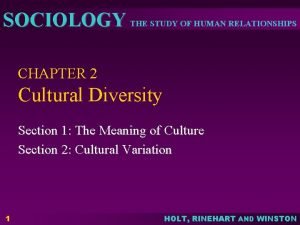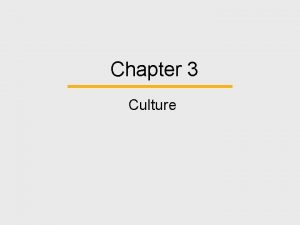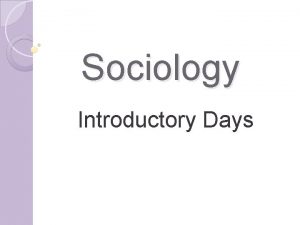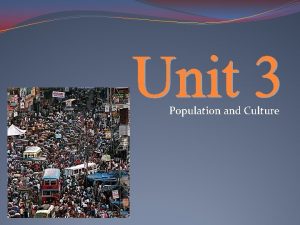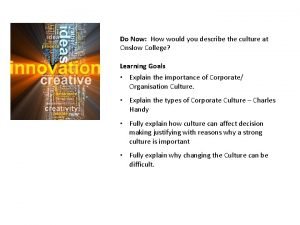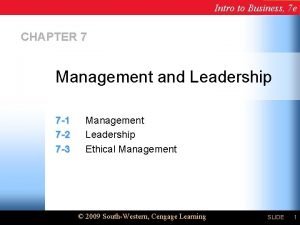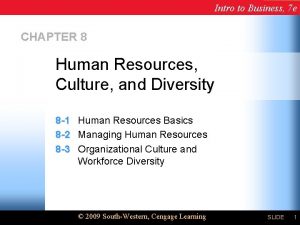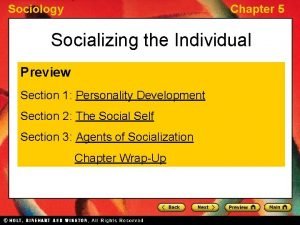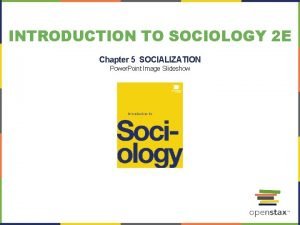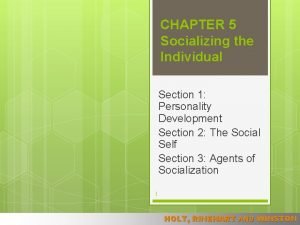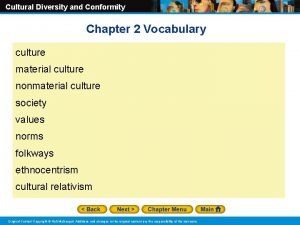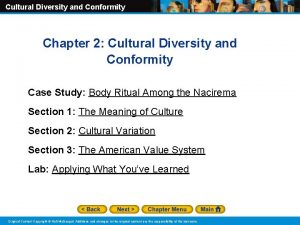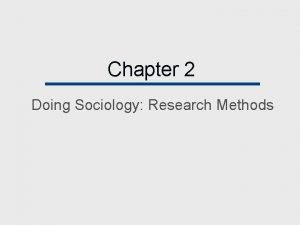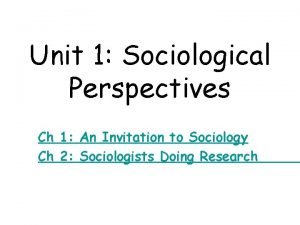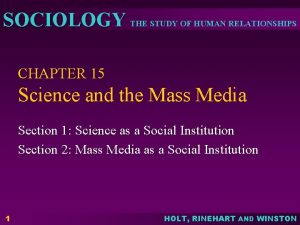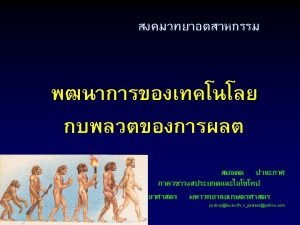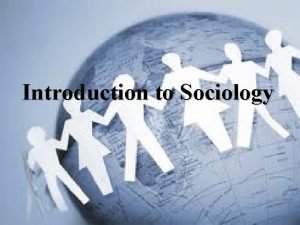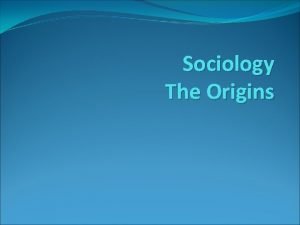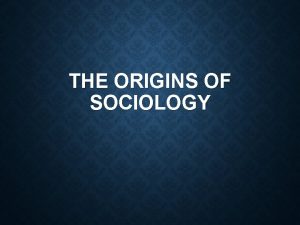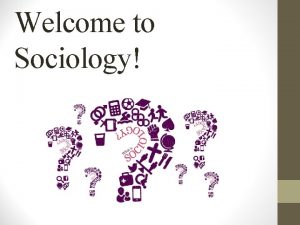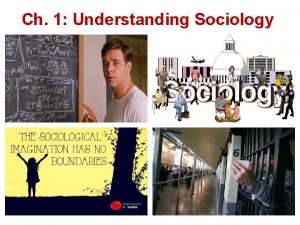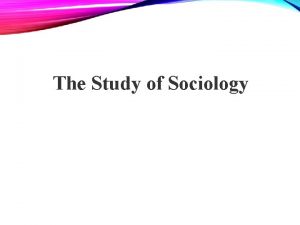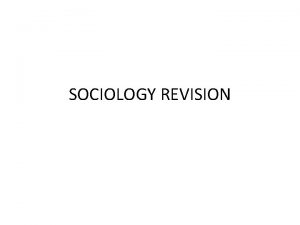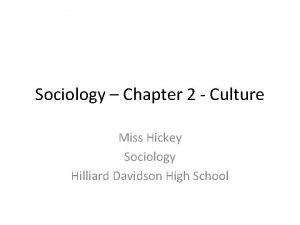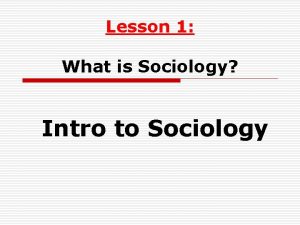Sociology Chapter 3 CULTURE Intro to Culture Definitions
























- Slides: 24

Sociology Chapter 3 CULTURE

Intro to Culture Definitions • Culture- The beliefs and behaviors that a social group shares • Society- A group of people who share a community (definable region) and a culture (beliefs and practices of a group) • *Neither society nor culture could exist without the other • *Text example of how we behave in a fast food restaurant*

What is Culture? 3. 1 -Most Human Behavior is Learned. EX’s • In the US marriage is for “love”- many other places it is arranged • We often shop for a week-many Europeans shop daily • We try to avoid physical contact with strangers on buses/trains. Japan hires people to shove people into buses/trains We know what we know and we want to be “normal” and secure that we won’t be challenged for our behaviors

Expressions of Culture Material Culture- Objects or belongings of a group of people. Ex’s: bus passes, cars, churches. Nonmaterial Culture- Ideas, attitudes and beliefs of a society. *They often interact, your style of clothes can make a statement, a bus pass indicates capitalism. Cultural Universals- Patterns or traits that are globally common to all societies. Ex’s: Music, funeral services, family units, humor- most CU’s are around shared experiences and/or survival.

Relating to Other Cultures • If you break it down to specifics- there are more cultural differences than similarities. Ex’s: Language and food- Cultural Universals or Difference? • Personal Space example. Ethnocentrism- Evaluating another culture in how it compares to your own. IE- belief that your own culture is superior. *Those darn British drive on the wrong side of the road. *It is normal and healthy to appreciate your own culture- but it can go too far.

Relating to Other Cultures- Cont’d Cultural Imperialism- The deliberate imposition of one’s own cultural values on another culture. Ex’s- Native American boarding schools, conquistadores, encomienda system, Inquisitions, Sharia, Democracy in the ME………… Your Ex? Culture Shock- The disorientation and frustration that occur when confronted with a different culture. Fun at first but that wears off and becomes stressful Wears off as the more you learn about the new culture, the more comfortable you become. Have any of you experienced culture shock?

Relating to Other Cultures- Cont’d Cultural Relativism- Assessing culture a by its own culture and not by your own. Some issues can make this very hard. EX- female genital mutilation- practiced in many areas of the world. Xenocentrism- When someone believes that another culture is superior to their own. Can be really hard for exchange students or a sociologist returning from the field. *Everybody has biases and being aware of them can help keep them in check

3. 2 Elements of Culture Values- Are a culture’s standard for discerning what is good and just in a society. Values are deeply embedded and critical for transmitting and teaching a culture’s beliefs. Beliefs- Are the tenets or convictions that people hold to be true. EX- The belief in the American Dream that hard work will bring success and wealth. Our value is that wealth is good and important EX- We value courage and believe that soldiers deserve respect

Elements of Culture Continued *Values suggest how we should behave- but reality is another story* Ideal Culture- The standards society would like to embrace. EX’s. We should all live a healthy lifestyle. Students should all maximize their education etc Real Culture- Crime, racism etc. In groups of 3 think of an example of real vs ideal culture

Values into Action The three ways that societies put values into actions are: 1. Rewards- When you observe the norms of society you often receive a reward like a thank you or maybe a plague or a bonus. 2. Sanctions- Are a societies approval or disapproval for certain actions. They can be formal like being fired or informal like a thank you or a frown. 3. Punishments- Breaking social norms can lead to loss of job, imprisonment etc. Also people can be labeled. *The above can be interpreted differently from culture to culture- male hand holding is a good example.

Norms- Tell us what is “normal” in our society Formal Norms- These are established, written rules. Laws are examples as so are college entrance requirements, drug testing at work. Formal norms are the most clearly stated and specific of the norms. Informal Norms- Casual behaviors that are generally and widely conformed to. EX’s- standing in line, using a napkin at a restaurant, calling me Mr. Dion. What are some other examples of informal norms?

Other Kinds of Norms Mores- Are norms that have a moral basis. Adultery, murder, public drunkenness, body odor, plagiarism. The more serious ones are backed by lack and lesser ones by public disapproval Folkways- Norms with no moral basis. When to shake hands, not wearing a tie etc. Folkways vary dramatically from society to society Breaching Experiments- On page 63 - testing what people do when someone around them “breaches” behaves in a socially awkward manner. EX- starting a conversation with a stranger at a urinal. These experiments are valuable in uncovering many of the unwritten rules we live by.

Symbols and Language Symbols- Provide clues to help understand the world. Some are real useful like signs and others convey nonmaterial meaning like wedding rings, blue ribbons. A symbol used out of context can carry a strong message. A soldier with a peace sign on their uniform. Symbols can also convey information when they are destroyed- burning flags. Language- The most universal of all symbols. All cultures have language but even within a culture subtle information is carried regarding class/education etc. Do you call it a pop or soda. Language also reflects the changes in a society- internet/LOL/YOLO.

Sapir-Whorf Hypothesis SWH -AKA the Theory of Linguistic Relativity People understand their world through the meaning embedded in their language. • Eskimos have 12 words for snow and ice • American English has the most words for time • Some Native American tribes have about half their language for horse terms *Even within a language the type of words you use convey meaning

Nonverbal Communication http: //www. funtrivia. com/playquiz/quiz 31230423 c 0 d 88. html Gestures can vary a lot between cultures. Log on and take the quiz at the above address. Some nonverbal communication is universal- smile, folded arms and hands on hips are good examples. America’s attitudes towards bilingualism is different than Australia’s https: //www. youtube. com/watch? v=MOno. SA-iazo

High Brow and Low Brow The US has a national culture, but even within this there are types of cultures. One of the major delineations is the distinction between High Culture and Popular Culture. High Culture- These are things that the elite in society do. They usually cost a lot of money. EX’s Opera, Ballet. They involvement in high culture usually implies prestige, intellectualism and political/economic power Popular Culture- Those things that everybody has access to and most can talk about it. EX’s American Idol, Seahawks, pop music

Subculture and Counterculture Subculture- A smaller cultural group within a larger group. Bikers, ethnic and racial groups, Amish, Mennonites etc. Counterculture- A subculture that doesn’t buy into many of the values and beliefs of the main culture. Sometimes they even from their own “Utopian” communities. Polygamists, racists (Idaho), communes, hipsters- see page 67 -68. Hipsters-Jazz-Beatniks-Hippies Cult- A counterculture usually a religious group with a charismatic leader. Jim Jones, Yearning for Zion, David Koresh are examples

Cultural Change Culture is always evolving with material advancements Innovation- An object or concept’s initial appearance in society. The two ways that this happens are discoveries and inventions. Discovery- Make known something that already exists. Columbian Exchange, Galileo, horses. Inventions- When something new is formed from existing objects or concepts. Electric appliances, silicon chip, cars etc. Culture Lag- The time lapse between the introduction of a new material object and when it becomes an accepted part of nonmaterial culture. Sometimes this can create generation gaps

Graph of Cultural Lag Figure 3. 9 Sociologist Everett Rogers (1962) developed a model of the diffusion of innovations. As consumers gradually adopt a new innovation, the item grows toward a market share of 100 percent, or complete saturation within a society. (Graph courtesy of Tungsten/Wikimedia Commons)

Contemporary Issues The world is smaller than ever and continuing to shrink Globalization- The integration of international trade and finance markets. Multinational companies are a big part of this. Also increased communication and travel facilitate the flow of goods, information and people. Diffusion- The spread of material and nonmaterial culture. This coincides with globalization. This really shows up in the foods we eat. *The diffusion of American culture is a major world issue* Can you think of other examples of diffusion?

Functionalist View of Culture Society is a system where all parts work to create society as a whole • Culture exists to meet members’ basic needs • Values are an important part of a societies culture- US values education, fairness, individuality etc • Culture consists of material object like classrooms, books and nonmaterial aspects like values, concepts and beliefs

Conflict Theory on Culture Conflict theorists view social structure as inherently unequal • Culture is seen as perpetuating the inequalities of race, gender, age • The source of many of these inequalities is found in a society’s value system- Youth, Wealth etc • The core of conflict theory is the effect of economic production and materialism ie Industrialization and the concentration of wealth and power • The “American Dream” perpetuates the belief in privileges for the wealthy

Symbolic Interactionism Most concerned with face-to-face interactions between members of a society. • Culture is created and maintained by the way people interact and interpret each other’s actions • People continually derive meaning from the objects and actions of others • Language is a major symbol used in interpreting meaning-SWH • To a SI proponent, culture is highly dynamic and fluid

Final Thoughts About Culture • Culture is all the practices, beliefs, values and behaviors of a society • Culture is learned • Culture influences the way we act and perceive our world and the world around us • Culture is social comfort- makes us comfortable knowing how to behave • Culture is the glue that enables societies and nations to exist without • When we study other cultures, we understand our own better
 Norms sociology examples
Norms sociology examples Cultural leveling vs diffusion
Cultural leveling vs diffusion Culture definition sociology
Culture definition sociology Ladette culture sociology definition
Ladette culture sociology definition Nature of culture
Nature of culture Types of culture in sociology
Types of culture in sociology Parallelism for paired ideas
Parallelism for paired ideas Chapter 13 sentence check 1 answer key
Chapter 13 sentence check 1 answer key Intro to business chapter 10 test answers
Intro to business chapter 10 test answers Intro to business chapter 7
Intro to business chapter 7 Introduction to business chapter 8
Introduction to business chapter 8 Anaerobic exercise physiology
Anaerobic exercise physiology Chapter 1 introduction to forensic science and the law
Chapter 1 introduction to forensic science and the law Intro to business chapter 10
Intro to business chapter 10 Chapter 7 learning goals outline sociology
Chapter 7 learning goals outline sociology Sociology chapter 5 socialization
Sociology chapter 5 socialization Sociology chapter 5 socialization
Sociology chapter 5 socialization Sociology chapter 8 deviance and social control
Sociology chapter 8 deviance and social control Sociology chapter 5 socializing the individual
Sociology chapter 5 socializing the individual Cultural diversity and conformity
Cultural diversity and conformity Sociology chapter 1 review
Sociology chapter 1 review Examples of countercultures
Examples of countercultures Advantage and disadvantage of observation method
Advantage and disadvantage of observation method Chapter 1 an invitation to sociology answers
Chapter 1 an invitation to sociology answers Sociology chapter 15
Sociology chapter 15
